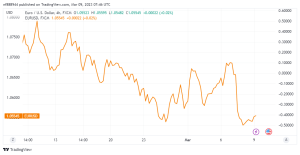In the early European session, the EURUSD has extended its rebound over the immediate barrier of 1.0550. The main currency pair struggled to rebound from 1.0540 as the DXY gave up the important support level of 105.20. A variety of criteria must be met by the shared currency pair in order to generate an upward bias.
The focus is on nonfarm payrolls in the United States.
There is no doubting that Federal Reserve Powell has already warned the market that the central bank is willing to boost interest rates. Further in order to reduce persistent inflation. But, the publication of nonfarm payrolls (NFP) statistics in the United States on Friday will give further clues. According to projections, the official US Employment Report for February will indicate a decrease in the number of payrolls increased to 203K from the previous release of 514k. A total of 203K is not awful, but it pales in comparison to January’s record of 514K. Investors should be aware that a figure of 514K was unusual in the previous seven months.
Apart from that, the unemployment rate is likely to stay stable at multi-decade lows. In addition, the average hourly wage is predicted to rise 4.8% on an annual basis as labor shortages are countered by greater compensation. Households with more money in their pockets may be more resilient in their spending.
EURUSD Technical Analysis
On a four-hour period, EURUSD is producing an Inverted Flag chart pattern around the horizontal support set from the February 27 low of 1.0533.
The chart pattern suggests a lengthy consolidation followed by a collapse. Typically, the consolidation phase of the chart pattern works as an inventory adjustment. Which those players who choose to enter an auction after establishing a negative bias begin shorts.

The Euro may continue to see selling pressure at the 20-period Exponential Moving Average (EMA) of 1.0583.
The Relative Strength Index (RSI) (14) fluctuation in the 20.00-40.00 area suggests that the bearish momentum is active at the time. The momentum indicator shows no signs of divergence or oversold conditions.









